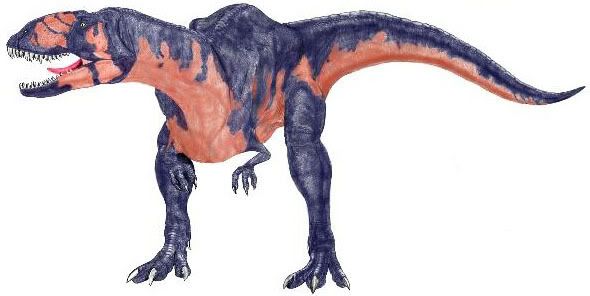Post by Barry the Baryonyx on Jun 25, 2007 16:00:24 GMT -5
Abelisaurus

Pic by Dinosauricon
Abelisaurus - ah-BEL-i-SAWR-us ("Abel's lizard") is a genus of abelisaurid theropod dinosaur from the Late Cretaceous Period of what is now South America. It was a bipedal carnivore that probably reached 25 to 30 feet (7 to 9 meters) in length, although it is known from only one partial skull.
The generic name recognizes Roberto Abel as the discoverer of the specimen and former director of the provincial Museum of Cipolletti in Argentina, where the specimen is housed. It also incorporates the Greek σαυρος/sauros, meaning 'lizard'. There is one named species, A. comahuensis, which honors the Comahue region of Argentina, where the fossil was found. Both genus and species were named and described by Argentine paleontologists Jose Bonaparte and Fernando Novas in 1985, who placed it in the newly-created family Abelisauridae.
Many other abelisaurids have since been discovered, including extremely complete specimens of Aucasaurus, Carnotaurus and Majungatholus. Some scientists place Abelisaurus as a basal abelisaurid, outside the subfamily Carnotaurinae. Others are less certain of its position. Abelisaurids share some skull features with the unrelated carcharodontosaurids and, since Abelisaurus is known only from a skull, future discoveries may show that this genus was in fact a carcharodontosaurid. However, this is thought unlikely.
The one known fossil skull of Abelisaurus is incomplete, especially on the right side. It is also missing most of the palate (roof of the mouth). Despite the missing pieces, it is over 33 inches (85 centimeters) long. Although there are no bony crests or horns, like those found in some other abelisaurids, such as Carnotaurus, rough ridges on the snout and above the eyes might have supported some kind of crest made out of keratin, which wouldn't have become fossilized. There are also very large fenestrae (window-like openings) in the skull, which are found in many dinosaurs and reduce skull weight.
Disputed Age
Abelisaurus is one of the many dinosaurs that have been discovered in Patagonia. It was originally described as coming from the Allen Formation but subsequent research proved the remains were actually found in the older Anacleto Formation (part of the Neuquén Group) of Rio Negro Province, Argentina. The Anacleto is a geologic formation in South America, dating from the early Campanian stage of the Late Cretaceous Period, between 83 and 80 million years ago.
Scientific classification
Kingdom: Animalia
Phylum: Chordata
Class: Sauropsida
Superorder: Dinosauria
Order: Saurischia
Suborder: Theropoda
Infraorder: Ceratosauria
Family: Abelisauridae
Genus: Abelisaurus
Species: A. comahuensis

Pic by Dinosauricon
Abelisaurus - ah-BEL-i-SAWR-us ("Abel's lizard") is a genus of abelisaurid theropod dinosaur from the Late Cretaceous Period of what is now South America. It was a bipedal carnivore that probably reached 25 to 30 feet (7 to 9 meters) in length, although it is known from only one partial skull.
The generic name recognizes Roberto Abel as the discoverer of the specimen and former director of the provincial Museum of Cipolletti in Argentina, where the specimen is housed. It also incorporates the Greek σαυρος/sauros, meaning 'lizard'. There is one named species, A. comahuensis, which honors the Comahue region of Argentina, where the fossil was found. Both genus and species were named and described by Argentine paleontologists Jose Bonaparte and Fernando Novas in 1985, who placed it in the newly-created family Abelisauridae.
Many other abelisaurids have since been discovered, including extremely complete specimens of Aucasaurus, Carnotaurus and Majungatholus. Some scientists place Abelisaurus as a basal abelisaurid, outside the subfamily Carnotaurinae. Others are less certain of its position. Abelisaurids share some skull features with the unrelated carcharodontosaurids and, since Abelisaurus is known only from a skull, future discoveries may show that this genus was in fact a carcharodontosaurid. However, this is thought unlikely.
The one known fossil skull of Abelisaurus is incomplete, especially on the right side. It is also missing most of the palate (roof of the mouth). Despite the missing pieces, it is over 33 inches (85 centimeters) long. Although there are no bony crests or horns, like those found in some other abelisaurids, such as Carnotaurus, rough ridges on the snout and above the eyes might have supported some kind of crest made out of keratin, which wouldn't have become fossilized. There are also very large fenestrae (window-like openings) in the skull, which are found in many dinosaurs and reduce skull weight.
Disputed Age
Abelisaurus is one of the many dinosaurs that have been discovered in Patagonia. It was originally described as coming from the Allen Formation but subsequent research proved the remains were actually found in the older Anacleto Formation (part of the Neuquén Group) of Rio Negro Province, Argentina. The Anacleto is a geologic formation in South America, dating from the early Campanian stage of the Late Cretaceous Period, between 83 and 80 million years ago.
Scientific classification
Kingdom: Animalia
Phylum: Chordata
Class: Sauropsida
Superorder: Dinosauria
Order: Saurischia
Suborder: Theropoda
Infraorder: Ceratosauria
Family: Abelisauridae
Genus: Abelisaurus
Species: A. comahuensis


 Is it just us?
Is it just us?